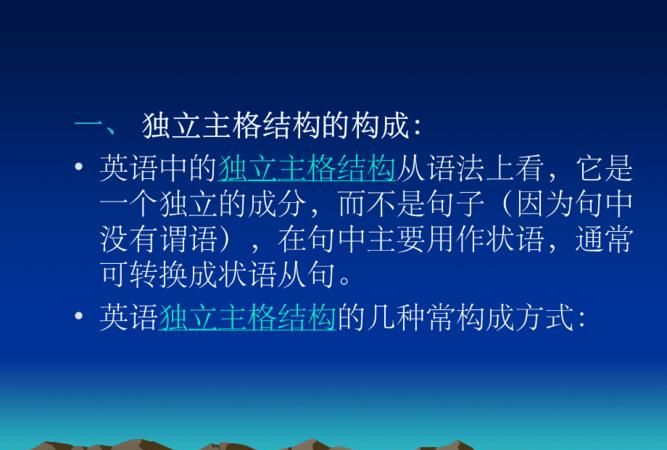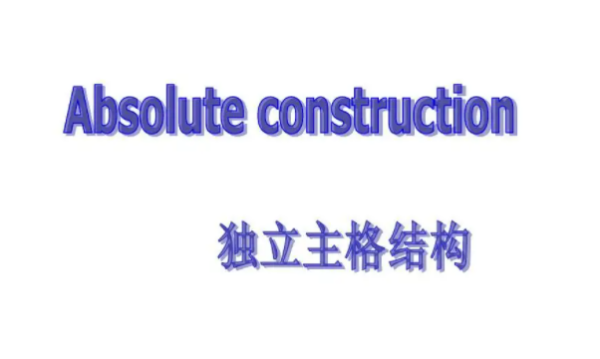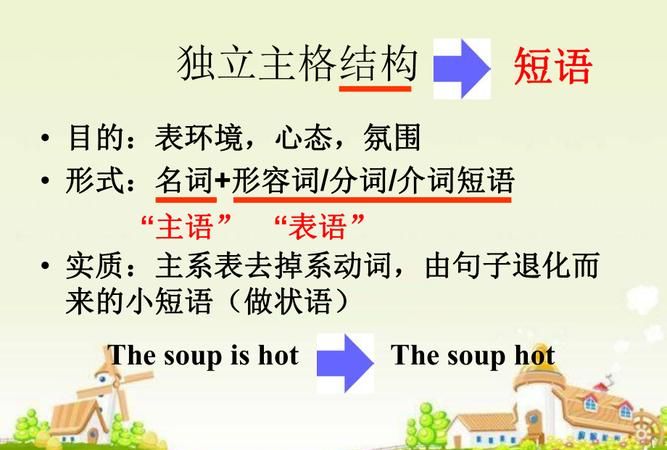本文目录
独立主格的用法
独立主格结构是一个独立主格的名词或代词(作为逻辑主格),加上一个分词、形容词、副词、不定式、介词短语。其作用相当于状语,多用来表示行为、方式或伴随的情况,有时也用来表示时间和条件。这种结构多用在书面语中。
一、几种常见的独立主格结构形式
1.名词(或代词)+现在分词(或过去分词)。如:
1)The moon appearing,they decided to go on with theirjouney.
2)Good-bye said,he went home.
2.名词(或代词)+形容词。如:
3)The weather(being)hot,we all went swimming.
3.名词(或代词)+不定式。如:
4)Some of the money to be paid by the thief, the policewent.
4.名词(或代词)+介词短语。如:
5)He climbed in,sword in hand.
5.名词(或代词)+副词。如:
6)The meeting(being)over, we left the room.
独立主格结构的模式是:
主格名词/代词 + 分词/形容词/副词/不定式/介词短语
(作逻辑主语) (作逻辑谓语)
1. All our savings gone, we started looking for jobs.
2. The question settled, we went home.
3. The river having risen in the night, the crossing was impossible.
主格名词/代词 + 分词 (过去分词/现在分词)
主格名词/代词 + 形容词
1. His mother being ill, he had to stay home to look after her.
2. Other things being equal, I would buy the black dress.
主格名词/代词 + 副词
The meeting being over, our headmaster soon left
the meeting-room.
We to care for the children, you are able to be carefree
away from home.
主格名词/代词 + 不定式
主格名词/代词 +介词短语
Our English teacher came into the classroom, papers in hand.
with复合结构 与 独立主格结构
它们都可以在句中作原因状语,伴随状况状语,条件状语,时间状语或结果状语用,一般也可以相互转换.虽然它们的语法功能和意义相同,但其结构形式和名称却不相同.
with复合结构的模式是:
with+名词/代词+分词/形容词/副词/不定式/介词短语
独立主格结构的模式是:
主格名词/代词+分词/形容词/副词/不定式/介词短语
一,作时间状语
1,With winter coming on, the trees turn yellow and
some birds fly south.
=Winter coming on, the trees turn yellow and some
birds fly south.
二,作原因状语
1,With the weather terribly cold, we entered the
room to warm ourselves.
= The weather terribly cold, we entered the room to warm ourselves.
2,With the key having been lost, she could not
enter the room.
= The key having been lost, she could not enter the room.
三,作条件状语
1,With time permitting, we'll visit the Summer Palace.
= Time permitting, we'll visit the Summer Palace.
2,With the car going wrong, we'll have to stop
at the foot of the mountain.
= The car going wrong, we'll have to stop at the foot
of the mountain.
四,作伴随状语
1,The mother was cleaning the house with her baby
playing on the bed.
=The mother was cleaning the house, her baby playing
on the bed.
2,Last night I followed him, with a sword in my hand.
= Last night I followed him , sword in hand.
无论with复合结构还是独立主格结构,都不可有动词的谓语形式充当其中的逻辑谓语.如下例中的was就必须去掉:
He sat at the desk reading
with a pen was in his right hand.
with复合结构可以作后置定语修饰名词,而独立主格结构则不可作后置定语修饰名词.
Soon she arrived at a park with grass green and
flowers in blossom.
= Soon she arrived at a park whose grass was green
and whose flowers were in blossom.

独立主格是什么意思
独立主格是一种语法结构,由两部分组成,前一部分是名词或代词,后一部分是非谓语动词、形容词、副词、名词或介词短语,前后两部分具有逻辑主谓关系。
在英语中,谓语只能是动词,不是谓语的动词全部改成非谓语动词。独立主格结构多用于书面语, 其本身不是句子,它在句子中作状语,表时间、原因、条件、伴随、目的及状态等。

非谓语动词作状语,其逻辑主语须与主句主语保持一致。若不一致,非谓语动词形式须另带主语,从而构成复合结构的形式作状语。这种结构称为“独立结构”。其中,非谓语动词主动用现在分词,被动用过去分词。
功能:独立主格结构主要用于描绘性文字中,其作用相当于一个状语从句,常用来表示时间、原因、条件、行为方式或伴随情况等。
用法:独立主格结构主要表示谓语动词发生的时间、原因、条件或伴随情况等,相当于一个状语从句或并列句。

特点:
1、独立主格结构的逻辑主语与句子的主语不同,它独立存在。
2、名词或代词与后面的分词,形容词,副词,不定式,介词等是主谓关系或动宾关系。
3、独立主格结构一般有逗号与主句分开。
如何理解独立主格
独立主格结构是指用一个短语来表达相当于句子的概念,独立指其单独表达一近似完整的概念,主格指它用名词代词 来充当逻辑主语,说它是是指这个名词代词,是后边动作的发出者 独立主格结构可以化简复合句。将从句化为独立主格结构。这种化简是在 从句主语与主句主语不同时才可以进行。从句主语充当独立主格结构的逻辑主语。
独立主格的构成:逻辑主语 (名词 代词)+ 分词 (现在分词,过去分词,以及形容词、副词、介词短语等)
独立主格结构。通常作状语。用来表示 时间 条件 原因 方式 等。
如:
Weather permitting, we will have a picnic tomorrow.
若是天气许可,我们明天要去野餐。
还原后:If the weather permits, we will have a picnic tomorrow.
其中,weather permitting就是一个独立主格结构,其形式就是主语+分词短语。
又如:
The sun having set, we started for home.
=As the sun had set, we started for home.
夕阳西下了,我们就动身回家。
再如:
Gun in hand, he fears nothing.
枪在手,他什么也不怕。

用作独立主格结构是什么意思
独立主格结构(Absolute Construction)由两部分组成,前一部分是名词或者代词,后一部分是非谓语动词(不定式、现在分词、过去分词)或形容词、副词、名词或介词短语。前后两部分具有逻辑主谓关系。
在英语中,动词按作用和功能主要分为两大类,一类是谓语动词,另一类是非谓语动词。独立主格结构在句中作状语,多用于书面语。 独立主格结构本身不是句子,在句子中作状语,表时间、原因、条件、伴随、目的及状态等。

扩展资料:
用法:
独立主格结构主要表示谓语动词发生的时间、原因、条件或伴随情况等,相当于一个状语从句或并列句。
【1】用作时间状语
The work done(=After the work had been done), we went home. 工作完成后,我们就回家了。
【2】用作条件状语
Weather permitting(=If weather permits), they will go on an outing to the beach tomorrow. 如果天气允许的话,他们将在明天组织一次海滨小游。
【3】用作原因状语
An important lecture to be given tomorrow(=As an important lecture will be given tomorrow), the professor has to stay up late into the night. 因为明天要发表一个重要的演讲,教授不得不熬夜到很晚。
【4】用作伴随状语
He was lying on the grass,his hands crossed under his head(=and his hands were crossed under his head).他躺在草地上,将两手交叉枕在脑后。
【5】用作补充说明
We redoubled our efforts,each man working like two. 我们加倍努力,一个人干两个人的活。
*注:独立主格结构表示时间、条件或原因时,相当于一个状语从句,一般放在句首,表示原因时还可放在句末;表伴随状况或补充说明时,相当于一个并列句,通常放于句末。
参考资料:百度百科-独立主格结构
以上就是关于独立主格表示结果 ,独立主格的用法的全部内容,以及独立主格表示结果 的相关内容,希望能够帮到您。

